The quest for flawless, even-toned skin is not new—it’s timeless. Among the many beauty treatments available today, full body whitening treatment(عملية تبييض الجسم كامل)is gaining rapid popularity across the globe. Whether for addressing hyperpigmentation, sun damage, or simply achieving a more radiant look, many individuals are turning to this comprehensive skin-brightening approach.
This article dives deep into what full body whitening entails, the different techniques available, the benefits, side effects, and what to expect before and after the treatment. From ingredients to cost, this is your complete guide.
What Is Full Body Whitening Treatment?:
Full body whitening treatment is a cosmetic procedure designed to lighten and even out the skin tone across the entire body. It targets pigmentation issues, blemishes, dark spots, and uneven areas, aiming to create a smoother, lighter, and more radiant complexion. Unlike spot treatments that focus on specific areas, this treatment covers the body from head to toe.
The treatment may involve the use of chemical peels, laser therapy, topical creams, IV drips, or natural remedies, depending on the individual’s needs and desired outcome. It’s essential to consult a qualified dermatologist or skincare expert before undergoing any procedure.
Why People Choose Full Body Whitening:
People opt for skin whitening for various personal and cultural reasons. Here are some of the most common motivations:
-
Even skin tone: To reduce the appearance of dark patches or uneven pigmentation
-
Boosted confidence: Feeling more comfortable in one’s skin
-
Correct sun damage: Reversing years of exposure to UV rays
-
Minimizing scars: Lightening acne marks, stretch marks, or injury scars
-
Special occasions: Preparing for weddings or public appearances
Types of Full Body Whitening Treatments:
There is no one-size-fits-all when it comes to skin whitening. Here’s a breakdown of the most common treatment options:
1. Topical Whitening Creams and Serums:
-
Contain ingredients like glutathione, kojic acid, vitamin C, and arbutin
-
Usually applied daily over a period of weeks or months
-
Non-invasive and affordable
-
Suitable for minor discoloration or maintenance
2. Chemical Peels:
-
Use acids like glycolic acid, salicylic acid, or lactic acid
-
Exfoliate the top layer of skin to reveal lighter, smoother skin beneath
-
Offer gradual results over multiple sessions
-
Require post-treatment care due to potential sensitivity
3. Laser Therapy:
-
Targets melanin deposits in the skin using focused light energy
-
Effective for treating deep pigmentation and dark spots
-
Requires professional application in a clinic setting
-
Downtime and multiple sessions may be needed
4. Glutathione IV Drips:
-
Administered intravenously in a medical spa or dermatology clinic
-
Glutathione is an antioxidant that inhibits melanin production
-
Shows systemic results across the body
-
Should only be performed under professional supervision
5. Natural and DIY Methods:
-
Ingredients like turmeric, lemon juice, and honey used in home remedies
-
Less effective than clinical treatments but budget-friendly
-
Risk of irritation or allergic reactions if misused
-
Better suited for mild brightening or temporary glow
Key Ingredients to Look For:
When exploring whitening products or undergoing professional treatment, it’s helpful to know the active agents that drive results:
-
Glutathione: A master antioxidant that reduces melanin production
-
Kojic Acid: Derived from mushrooms; effective in lightening pigmentation
-
Vitamin C: Boosts radiance and supports collagen production
-
Niacinamide: Brightens skin while improving texture
-
Licorice Extract: Soothes skin while inhibiting melanin synthesis
-
Arbutin: A natural brightening compound from bearberry plants
Potential Benefits of Full Body Whitening:
When done correctly and safely, these treatments offer a wide range of benefits:
-
A visibly brighter and even complexion
-
Reduction in dark spots, blemishes, and pigmentation
-
Increased skin smoothness and clarity
-
Improved self-image and confidence
-
Anti-aging effects through antioxidant properties
Possible Side Effects and Risks:
No cosmetic treatment is entirely risk-free. It’s crucial to weigh the pros and cons before deciding:
-
Skin sensitivity or irritation: Especially after chemical or laser treatments
-
Allergic reactions: Due to certain ingredients in creams or peels
-
Sun sensitivity: Treated skin becomes more vulnerable to UV rays
-
Uneven results: If not done by professionals
-
Overuse consequences: Excessive use of whitening agents can cause thinning or damage
Always follow your dermatologist’s guidance, and never attempt aggressive treatments at home.
Who Is a Good Candidate?:
Full body whitening treatments are generally suitable for:
-
People with uneven skin tone or hyperpigmentation
-
Those with post-inflammatory marks from acne or injuries
-
Individuals preparing for special occasions or events
-
Anyone seeking a long-term solution for skin brightness
However, those with very sensitive skin, certain allergies, or chronic skin conditions like eczema or psoriasis should consult a medical professional before proceeding.
Pre- and Post-Treatment Care Tips:
Proper care before and after treatment helps ensure better results and reduced side effects:
Before treatment:
-
Avoid sun exposure and tanning beds
-
Discontinue use of harsh exfoliants
-
Perform a patch test if using a new product
After treatment:
-
Apply sunscreen religiously (SPF 50+ recommended)
-
Use gentle cleansers and moisturizers
-
Stay hydrated and follow a balanced diet
-
Avoid heat, excessive sweating, and friction on the skin
Myths and Facts:
There are several misconceptions about full body whitening. Let’s clarify a few:
-
Myth: Whitening treatments permanently change your skin color
Fact: Most treatments reduce pigmentation but don’t change your genetic skin tone permanently -
Myth: Natural ingredients are always safe
Fact: Even natural substances can cause irritation if misused or if allergic -
Myth: More product equals faster results
Fact: Overuse can damage the skin and lead to side effects
Alternatives to Full Body Whitening:
If you’re hesitant about intensive treatments, there are other ways to boost your skin’s radiance:
-
Regular exfoliation and hydration
-
Vitamin-rich diet (A, C, E, Zinc)
-
Using brightening masks or serums
-
Avoiding direct sun exposure
-
Embracing your natural glow with confidence
Final Thoughts:
Full body whitening treatment(عملية تبييض الجسم كامل) offers a variety of solutions for those seeking more radiant, even-toned skin. With options ranging from topical products to professional procedures like lasers or IV drips, there’s something for every skin type and budget. However, safety, moderation, and professional advice are key to achieving desired results without compromising skin health.
Before starting any treatment, educate yourself, consult a qualified dermatologist, and set realistic expectations. Skin is personal—what matters most is that you feel confident and comfortable in your own.







0 Comments